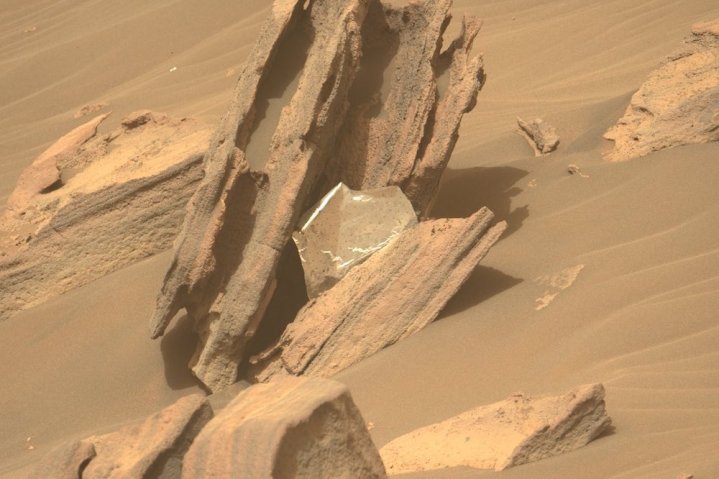NASA’s Mars rover recently made a surprise discovery on the distant planet, though sadly it’s not quite the evidence of ancient microbial life that scientists are hoping to find there.
Because it’s a piece of trash.
Specifically, the object, pictured below, appears to be a piece of a thermal blanket that was attached to Perseverance’s descent stage. The descent stage was part of the spacecraft that delivered Perseverance to the martian surface last year before performing a controlled crash landing well clear of the rover.

The discovery of the shiny piece of foil is somewhat unexpected as the descent stage came down more than a mile from the blanket’s current location.
In a series of messages posted on Perseverance’s Twitter account this week, the rover’s team at NASA’s Jet Propulsion Laboratory (JPL) in Southern California suggested it may have drifted there during the landing phase, or been blown to its new location by martian winds. There’s certainly no suggestion that hitherto undiscovered martians may have had something to do with it.
“My team has spotted something unexpected,” said a message on Perseverance’s Twitter account. “It’s a piece of a thermal blanket that they think may have come from my descent stage, the rocket-powered jet pack that set me down on landing day back in 2021.”
My team has spotted something unexpected: It’s a piece of a thermal blanket that they think may have come from my descent stage, the rocket-powered jet pack that set me down on landing day back in 2021. pic.twitter.com/O4rIaEABLu
— NASA's Perseverance Mars Rover (@NASAPersevere) June 15, 2022
Another post says thermal blankets protect a spacecraft’s components by regulating temperatures, adding: “It’s a surprise finding this here: My descent stage crashed about 2 km away. Did this piece land here after that, or was it blown here by the wind?”
That shiny bit of foil is part of a thermal blanket – a material used to control temperatures. It’s a surprise finding this here: My descent stage crashed about 2 km away. Did this piece land here after that, or was it blown here by the wind? pic.twitter.com/uVx3VdYfi8
— NASA’s Perseverance Mars Rover (@NASAPersevere) June 15, 2022
Another image features the JPL team that wrapped the rover in thermal blankets. “Think of them as spacecraft dressmakers,” the message says, adding, “They work with sewing machines and other tools to piece together these unique materials.”
Here’s part of the team at JPL that wrapped me up in thermal blankets. Think of them as spacecraft dressmakers. They work with sewing machines and other tools to piece together these unique materials.
More on that here: https://t.co/CNkUheYFnQ pic.twitter.com/PcMeow3FyO
— NASA’s Perseverance Mars Rover (@NASAPersevere) June 15, 2022
When not stumbling across landing leftovers, Perseverance is spending most of its time searching for evidence of past life on the red planet, and also collecting Mars rock samples for return to Earth. It might want to grab that trash while it’s at it, too.


